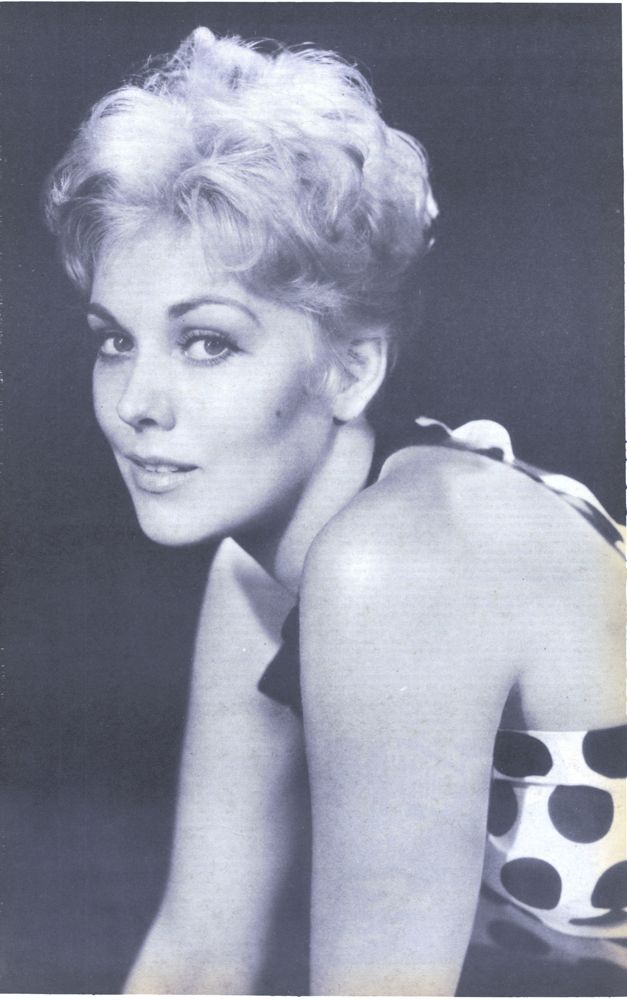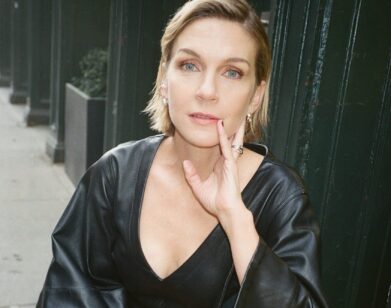New Again: Kim Novak

ABOVE: KIM NOVAK
Happy birthday Kim Novak! A Hitchcock icon, Kim Novak, who inspiredone of Alexander McQueen’s first “it” bags (the Novak), and turned down the role of Holly Golightly in Breakfast at Tiffany’s, turned 79 on Monday. The actress is, without a doubt, most famous for her role in Vertigo; however, Vertigo was not actually a success when it was first released. Hitchcock blamed its disappointing reception on Jimmy Stewart, who many criticized as being too old for his part, and promptly ejected Stewart from his next film, North by Northwest. Cary Grant, who is actually four years older than Stewart, took on the role intended for Jimmy. It was not until much later, the 1980s, that Vertigo attained its current reputation as one of the greatest films of the 20th century.
We first spoke to Kim 13 years after Vertigo, in March of 1981, and have reprinted part of the interview below. For those of you who know little about Novak outside of her icy blonde aesthetic, it seems that Ms. Novak is sort of a crunchy Californian, with a farm full of llamas and horses, and is married to a vet. Please forgive our fawning interviewer; after all, how would you feel if you got to meet (and be kissed by) Kim Novak?
Dream Date: Kim Novak
By John Calendo
This interview was done between flights, with Kim Novak coming out of the sky and then going back into it. She had come from Carmel, a rich seacoast community on the Monterey Peninsula where massive rocks poke out of the water and sea storms are frequent. There she lives with her husband, a veterinarian who came to her house one day to fix up a horse—one of the many horses, llamas, raccoons, and donkeys that roam free on her property, companions for whom she had her front door made especially high, especially wide and kept open always. The veterinarian was married at the time of his call. Not long after he was married again at a small outdoor ceremony to a woman—for many of us, one of the screen’s great ethereal women—whose films he had never seen, or had seen maybe one, but didn’t remember it all that much. Kim feels that this is the secret of her present contentment. She does not have to be Kim Novak, overcome Kim Novak, or live up to Kim Novak. No more the restless creature of fact and press-release fancy, “looking for herself” as only a ’50s romantic could… the beautiful beatnik Kim…
Fact is, Kim Novak is a happy woman, with a deep-pitched laugh and a deeper pitched voice that goes over things like velvet. (Her voice always makes me think of the fog—opaque, heavier than air, fuzzily tumbling down in slow motion.) Of course, there is always that extra thing about her too, that lost ’50s Blonde feeling, muted now, but there around the edges. Still, she is the blonde who survived. And she will smile here and tell you about what she has learned now that she has turne—completely, it seems—to the sea and the animals and a rocky coast where those things that get lost in the storm come back in another form, take root, and grow.
So deep is her contentment in her forest-secluded redwood house, so thorough is her affinity—affinity, an essential Kim Novak word—to her llamas, horses, dogs and the occasional pet snake, that she looks now at her work in movies as a hobby and her work in animal midwifing as he true vocation. (She refuses roles that will keep her more than a week or two from her beloved Monterey.) Kim Novak gets up at 5AM, is in bed at 9:30 PM, and is often found on her knees in a drafty barn, alongside her husband, helping a mare deliver its young.
She was changing planes at LAX because she was on her way to Dallas where a film festival was showing The Mirror Crack’d—an Agatha Christie jamboree in which Kim plays a wickedly funny movie star trading bitcheries with her—in her mind—supporting lady, Liz Taylor, while they remake Mary, Queen of Scots. “I’ll wipe that cow right off the screen,” vows Kim, in typical form. The she suits up for her jewel-encrusted role as Queen Elizabeth, tarting out nipple-revealing corsets and orange Annie wig: “We’ll have a scene where they meet in the Tower of London. There she’ll lie, covered with filth in rags, looking like shit… and the I’ll walk in!” It’s quite a movie.
In the picture, there’s a scene where Liz is cornered by a fan who goes on and on about the first time they met when the fan got an autograph, and the star was wearing a blue dress and had her hair just so and then she coughed and—on and on in a way that can only be described as delirious.
Reader, the interview that you are about to read teeters on that emotion. Reader, let’s be friends: it not only teeters, it totters! Kim Novak—her ’50s work, particularly—has always just knocked me out. Plus, she has a certain personal meaning for me. The first article I ever sold—to Interview, by the way—was about Kim Novak. In it, I contended that she was someone, like Greta Garbo, who critics did not appreciate as an actress because of their hang-ups about what movie acting was supposed to be. To me—and maybe to you too—Kim Novak could move across a room like she was moving under water, dreaming with her eyes open, unconsciously passing a hand through her butchie blonde hair, hesitate, “What if…,” hesitate, “What if I told you I was not like other people”—and be incredibly moving, strike home, connect. All those hesitations, that sort of ’50s neuroticism, combined powerfully with the cocktail beauty of Kim Novak. Novak, Garbo, and a few others had that same style: always hesitating, heavily unconscious, with a sort of animal feeling for moving and speaking. Critics will regularly miss the point and dismiss them; these women will reach their audience, regardless.
Anyway, here I was at the airport. Finally going to meet Kim Novak, totally nerved up. She comes out of the sky wearing a—believe it or not—lavender (all right, purple) blouse and corduroy pants as tight as a schoolboy’s. Her hair diagonals across her forehead and reaches her chin. She throws the hair out of her eye with a snap of her head and smiles at us. In one hand, she carries a felt hat with a long arching pheasant feather, over her arm is a coat made of coyote fur. We exit from the terminal.
JOHN CALENDO: Bill told me you really were into the color lavender. I though that was a 1950’s publicity thing.
KIM NOVAK: They picked up on that and made it into something. Actually, for a long time—when I was no longer working—I avoided it because it was like a press thing that was hanging on. And then I came to the point where I said to myself, Hey, I really do love the color. Why should I not—just because of that!
CALENDO: I loved The Mirror Crack’d.
NOVAK: Did you see it?
CALENDO: Oh yeah. What a wonderful role.
NOVAK: I’m anxious to see it.
CALENDO: You…?
NOVAK: No, I’ll see it tonight for the first time. In Dallas.
CALENDO: Oh, well, you steal the movie. And this was a great movie to steal. Your entrance is so great. Destroying Liz’s press party. I mean, here’s Liz playing the grand lady of the manor and you zip up in a pink convertible with loads of cleavage, pushing your way a la Jayne Mansfield into the photos being taken of Liz, calling her a cow, talking about double chins. It’s definitely a memorable moment in film.
NOVAK: Well, that was the very first scene I had to play—and, of course, it was a long time since I worked. We had no rehearsal. I just had to go up to Elizabeth with that dialog and, I mean, it was the first time I met Elizabeth, other than seeing her at premieres and waving hello. God, what is she going to do to me! I mean, that dialog! It was a terrible thing to say to someone I looked up to for years, really.
CALENDO: You looked like you were having a ball saying those lines, Kim.
NOVAK: Well, it was a fun thing. It’s not the kind of role I have ever played, really. It was just so different, so far out that I though I could just have fun with it, you know?
CALENDO: When you played the scene with Liz Taylor, I imagine you were both professionals and there were no problems.
NOVAK: No, none at all.
CALENDO: As much as a reporter might wish to the contrary.
NOVAK: [laughs] Sorry. I just think she’s beautiful and super. I felt so honored to be doing a film with her.
CALENDO: There are great Kim Novak moments in other movies, but this one—one constantly waits for you to come on screen. Every moment is like a best moment in a Kim Novak film.
NOVAK: Mmm, you’re so nice I’m going to kiss you. [She does]
CALENDO: I love Vertigo very, very much. Is it one of your favorites?
NOVAK: Definitely. I love paradoxical characters. I love playing two different roles because I feel this is very much where I am… in a way. I’m totally into two different ways of life.
CALENDO: Do you know that many critics consider Vertigo to be a perfect movie?
NOVAK: Really? It was panned at the time.
CALENDO: It’s very common, for instance, to hear that the best movie ever made was Citizen Kane. But revisionists are now saying it’s Vertigo. I think partly because—although Vertigo is very good—it’s rare now. Why is it never shown on TV anymore?
NOVAK: I don’t know.
CALENDO: There seems to be some legal case.
NOVAK: Oh? Perhaps.
CALENDO: The heir of the guy who wrote the original story, I think, has tied it up over a royalties dispute.
NOVAK: What ever happened to The Man With the Golden Arm? Do they ever show that on TV? I wonder if that was also a legal thing… This coat is sort of shedding. It’s coyote, so…
CALENDO: A fur? And you’re an animal lover?
NOVAK: Well, we’re trying to get rid of coyotes so they don’t get after our llamas. They have beautiful pelts—yeah, I wouldn’t want to wear the fur of some nice, safe animal.
CALENDO: But you feel it’s okay to wear coyote?
NOVAK: Well, I really do. Because they—not that I would go out and kill a coyote, particularly—but on the other hand, I don’t ask people who raise sheep and cattle about coyotes. I mean, they are definitely predators.
CALENDO: I have no problem with it. It just makes you more the, um, patron saint of llamas.
NOVAK: [laughs] They are gentle, gentle creatures. Proud and elegant and they need someone to watch over them. They really do because llamas are not the kind to be aggressive.
THIS FULL VERSION OF THIS INTERVIEW APPEARED IN OUR MARCH 1981 ISSUE.






